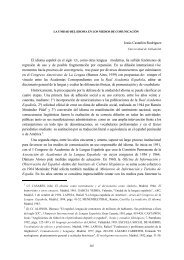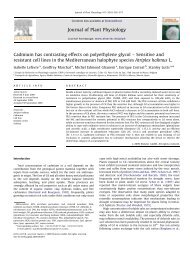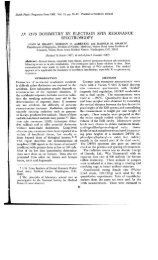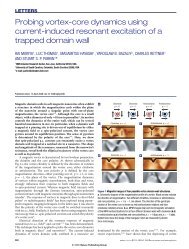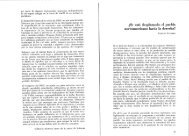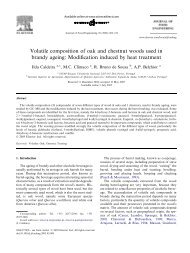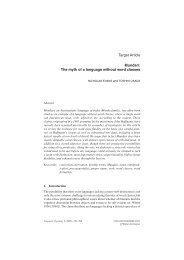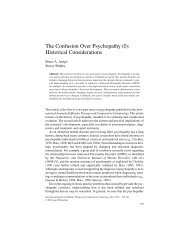Terpenoids: Opportunities for Biosynthesis of Natural Product Drugs ...
Terpenoids: Opportunities for Biosynthesis of Natural Product Drugs ...
Terpenoids: Opportunities for Biosynthesis of Natural Product Drugs ...
You also want an ePaper? Increase the reach of your titles
YUMPU automatically turns print PDFs into web optimized ePapers that Google loves.
eviews Ajikumar et al.<br />
strain, amorphadiene production reached a titer <strong>of</strong> 112.2 mg/<br />
L. By employing an optimized two-phase partitioning<br />
bioreactor, this same strain yielded 500 mg/L amorphadiene.<br />
180 Later, the same MVA pathway engineered strain was<br />
used <strong>for</strong> the additional heterologous expression <strong>of</strong> plant<br />
P450s derived from their native biosynthetic pathway <strong>for</strong><br />
the production <strong>of</strong> sesquiterpenes 8-hydroxycadinene and<br />
artemisinic acid at titers <strong>of</strong> 60 ( 2 mg/L and 105 ( 10 mg/L<br />
respectively. 181<br />
Metabolic Engineering <strong>of</strong> Terpenoid <strong>Product</strong>ion in<br />
Yeast. To date, ef<strong>for</strong>ts have focused primarily on E. coli;<br />
however, there are many advantages to using yeast as a host<br />
<strong>for</strong> terpenoid production. As with E. coli, overexpressions,<br />
deletions, or modifications to central metabolic pathways,<br />
as well as introduction <strong>of</strong> heterologous pathways, have been<br />
employed to improve precursor supply <strong>for</strong> yeast. Some <strong>of</strong><br />
these modifications have been adopted from prior bacterial<br />
engineering ef<strong>for</strong>ts in carotenoid production. The engineering<br />
ef<strong>for</strong>ts have resulted in yeast strains capable <strong>of</strong> producing<br />
high titers <strong>of</strong> up to 153 mg/L terpenoids (Table 2). 206<br />
(205) Pitera, D. J.; Paddon, C. J.; Newman, J. D.; Keasling, J. D.<br />
Balancing a heterologous mevalonate pathway <strong>for</strong> improved<br />
isoprenoid production in Escherichia coli. Metab. Eng. 2007, 9,<br />
193–207.<br />
(206) Ro, D.; Paradise, E. M.; Ouellet, M.; Fisher, K. J.; Newman,<br />
K. L.; Ndungu, J. M.; Ho, K. A.; Eachus, R. A.; Ham, T. S.;<br />
Kirby, J.; Chang, M. C. Y.; Withers, S. T.; Shiba, Y.; Sarpong,<br />
R.; Keasling, J. D. <strong>Product</strong>ion <strong>of</strong> the antimalarial drug precursor<br />
artemisinic acid in engineered yeast. Nature 2006, 440, 940–<br />
943.<br />
(207) Yamano, S.; Ishii, T.; Nakagawa, M.; Ikenaga, H.; Misawa, N.<br />
Metabolic Engineering <strong>for</strong> production <strong>of</strong> -carotene and Lycopene<br />
in Saccharomyces cereVisiae. Biosci., Biotechnol., Biochem.<br />
1994, 58, 1112–1114.<br />
(208) Miura, Y.; Kondo, K.; Shimada, H.; Saito, T.; Nakamura, K.;<br />
Misawa, N. <strong>Product</strong>ion <strong>of</strong> Lycopene by the Food Yeast, Candida<br />
utilis That Does Not <strong>Natural</strong>ly synthesize Carotenoid. Biotechnol.<br />
Bioeng. 1998, 58, 306–308.<br />
(209) Miura, Y.; Kondo, K.; Saito, T.; Shimada, H.; Frase, P. D.;<br />
Misawa, N. <strong>Product</strong>ion <strong>of</strong> the carotenoids Lycopene, -Carotene,<br />
and Astaxanthin in the Food yeast Candida utilis. Appl. EnViron.<br />
Microbiol. 1998, 64, 1226–1229.<br />
(210) Jackson, B. E.; Hart-Wells, E. A.; Matsuda, S. P. T. Metabolic<br />
Engineering to Produce Sesquiterpenes in Yeast. Org. Lett. 2003,<br />
5 (10), 1629–1632.<br />
(211) DeJong, J. M.; Liu, Y.; Bollon, A. P.; Long, R. M.; Jennewein,<br />
S.; Williams, D.; Croteau, R. B. Genetic Engineering <strong>of</strong> Taxol<br />
Biosynthetic Genes in Saccharomyces cereVisiae. Biotechnol.<br />
Bioeng. 2006, 93, 212–224.<br />
(212) Lindahl, A.; Olsson, M. E.; Mercke, P.; Tollbom, O.; Schelin,<br />
J.; Brodelius, M.; Brodelius, P. E. <strong>Product</strong>ion <strong>of</strong> the artemisinin<br />
precursor amorpha-4,11-diene by engineered Saccharomyces<br />
cereVisiae. Biotechnol. Lett. 2006, 28, 571–580.<br />
(213) Asadollahi, M. A.; Maury, J.; Møller, K.; Nielsen, K. F.; Schalk,<br />
M.; Clark, A.; Nielsen, J. <strong>Product</strong>ion <strong>of</strong> Plant Sesquiterpenes in<br />
Saccharomyces cereVisiae: Effect <strong>of</strong> ERG9 Repression on Sesquiterpene<br />
<strong>Biosynthesis</strong>. Biotechnol. Bioeng. 2008, 99, 666–677.<br />
(214) Shimada, H.; Kondo, K.; Fraser, P. D.; Miura, Y.; Saito, T.;<br />
Misawa, N. Increased Carotenoid <strong>Product</strong>ion by the food yeast<br />
Candida utilis through Metabolic Engineering <strong>of</strong> the Isoprenoid<br />
Pathway. Appl. EnViron. Microbiol. 1998, 64, 2676–2680.<br />
186 MOLECULAR PHARMACEUTICS VOL. 5, NO. 2<br />
Construction <strong>of</strong> Non-Native Downstream Terpenoid<br />
Pathways <strong>for</strong> New <strong>Product</strong>s. Prior to the year 2000,<br />
attempts to produce terpenoids in yeast can be summarized<br />
as biosynthesis <strong>of</strong> (1) lycopene and -carotene in S. cereVisiae;<br />
207 (2) lycopene, -carotene and astaxanthin in Candida<br />
utilis. 208,209 The first attempt by Yamano et al. 207 to produce<br />
terpenoids in S. cereVisiae by cloning CrtE, CrtB, CrtI, and<br />
CrtY genes <strong>for</strong> lycopene and -carotene used a Yep-13<br />
derived vector and individual promoters and terminators with<br />
each gene. Lycopene and -carotene accumulated together<br />
with their intermediates in the yeast cells. This was the first<br />
attempt to express a multigene metabolic pathway in a<br />
eukaryotic system. Though this attempt did not produce high<br />
titers, however, it demonstrated the potential <strong>for</strong> redirecting<br />
carbon flux toward an engineered carotenoid pathway away<br />
from the native downstream sterol synthesis. After this, Miura<br />
et al. 208,209 engineered another yeast strain, C. utilis, by<br />
expressing crtE, crtB, crtI, crtY, crtZ, and crtW to produce<br />
carotenoids. The C. utilis strain was chosen because <strong>of</strong> its<br />
ability to accumulate high amounts <strong>of</strong> ergosterol, which<br />
implied a high flux or precursor availability in the MVA<br />
pathway. 208 Here, the production was improved by using<br />
codon biased heterologous genes encoding the production<br />
<strong>of</strong> lycopene, -carotene, and anstaxanthin.<br />
Since the year 2000, the focus on engineering terpenoid<br />
production in yeast has shifted from carotenoids to high value<br />
therapeutic sesquiterpenes and diterpenes. Some <strong>of</strong> these<br />
recent attempts are production <strong>of</strong> epi-cedrol, 210 taxadiene-<br />
5R-acetoxy-10-ol, a precursor <strong>of</strong> paclitaxel, 211 amorpha-<br />
4,11-diene 213 and artemisinic acid precursors <strong>for</strong> artemisinin<br />
206 and valencene, cubebol, and patchoulol in engineered<br />
S. cereVisiae. 213<br />
Modifications to the Mevalonate Pathway To Increase<br />
the Precursor Supply. Most <strong>of</strong> the successful metabolic<br />
engineering approaches to yeast have been very similar and<br />
have focused on increasing flux through the mevalonate<br />
pathway by (1) increasing the flux from acetoacetyl-CoA to<br />
HMG-CoA by overexpressing the tHMG gene, (2) reducing<br />
the flux toward erosterol by targeting ERG9, and (3)<br />
overexpressing ERG20. Among these approaches, the downregulation<br />
<strong>of</strong> ERG9 seems to be the most effective at<br />
increasing the production <strong>of</strong> terpenoids. Since ergosterol is<br />
crucial <strong>for</strong> cell growth, there will always be a trade-<strong>of</strong>f<br />
between production <strong>of</strong> isoprenoids and growth rate.<br />
To improve the production <strong>of</strong> terpenoids, Shimada et al. 214<br />
attempted to increase the flux through the mevalonate<br />
pathway by overexpressing a truncated version <strong>of</strong> the native<br />
HMG reductase gene and deleting one allele <strong>of</strong> the ERG9<br />
gene in the diploid C. utilis. Neither modification improved<br />
terpenoid production individually; however, the combined<br />
modification improved lycopene accumulation 4-fold. The<br />
hypothesized mechanism <strong>for</strong> this improvement is that HMG-<br />
(215) Shiba, Y.; Paradise, E. M.; Kirby, J.; Ro, D. K.; Keasling, J. D.<br />
Engineering <strong>of</strong> the pyruvate dehydrogenase bypass in Saccharomyces<br />
cerevisiae <strong>for</strong> high-level production <strong>of</strong> isoprenoids.<br />
Metab. Eng. 2007, 9, 160–16.



